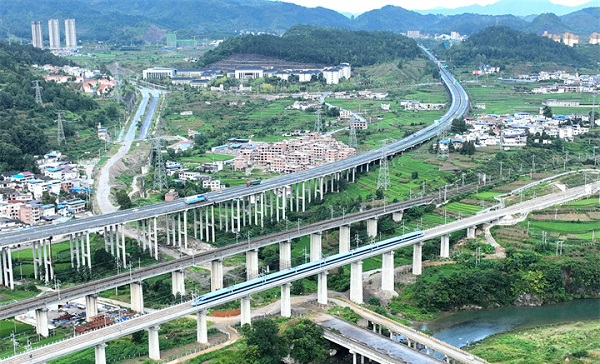Guiyang-Nanning High-speed Railway fully opens to traffic

The opening of the Guiyang-Nanning High-speed Railway is expected to boost the development of ethnic areas, rural vitalization, and opening-up. [Photo/ddcpc website]
The Guiyang-Nanning High-Speed Railway fully opens to traffic on Aug 31, connecting the cities Guiyang and Nanning in Guizhou province and Guangxi Zhuang autonomous region, fostering closer ties between Southwest and South China.
The railway is a key part of China's high-speed railway network's channel between Baotou and Haikou. Starting from Longli North Railway Station in Guiyang, the railway extends southwards through the Qiannan Bouyei and Miao autonomous prefecture in Guizhou and ends at Nanning East Railway Station in Guangxi.
The railway spans a length of 482 kilometers and is designed to operate at a speed of 350 kilometers per hour. It has 13 stations, including 11 newly built or expanded stations.
Construction on the rail posed numerous challenges, as it traverses complicated landscapes, making up 90 percent of the line's bridges and tunnels.
Initially, the Guiyang-Nanning High-speed Railway will operate according to regular, weekend, and peak schedules. Up to 56 high-speed trains run daily, including direct services connecting Nanning to Guiyang, Chengdu, and Chongqing.
Travel time between Nanning East Railway Station and Guiyang East Railway Station has been reduced from over five hours to a mere two hours and 53 minutes. Moreover, travel times from Nanning East Railway Station to Chengdu East Railway Station and Chongqing West Railway Station have been shortened to six hours and 51 minutes and five hours and 17 minutes, respectively.
The railway makes travel more convenient for people from various ethnic communities, including the Maonan, Yao and Bouyei ethnic groups, residing alongside the line.
The railway will not only enhance tourism and industrial growth, but also play a crucial role in supporting the development of ethnic areas, promoting rural vitalization, and facilitating high-level opening-up.
Presented by China Daily.
黔ICP备05001922号-3
